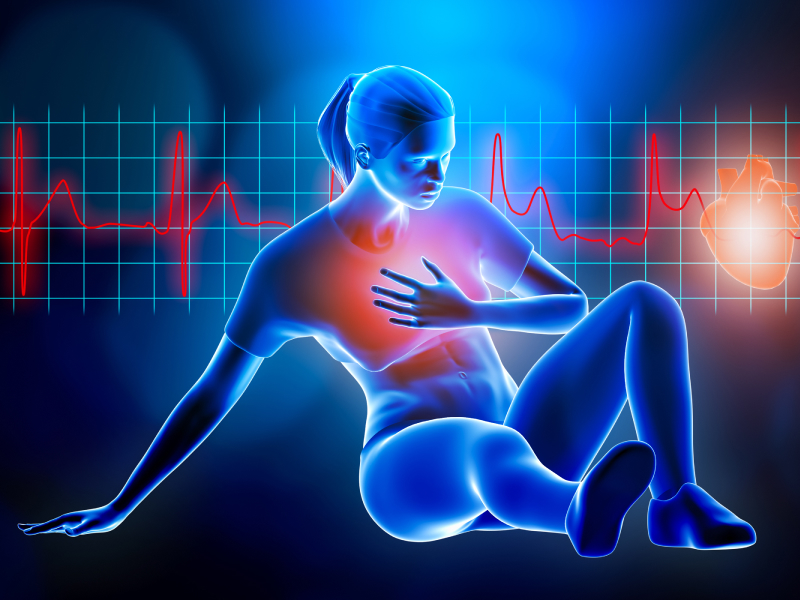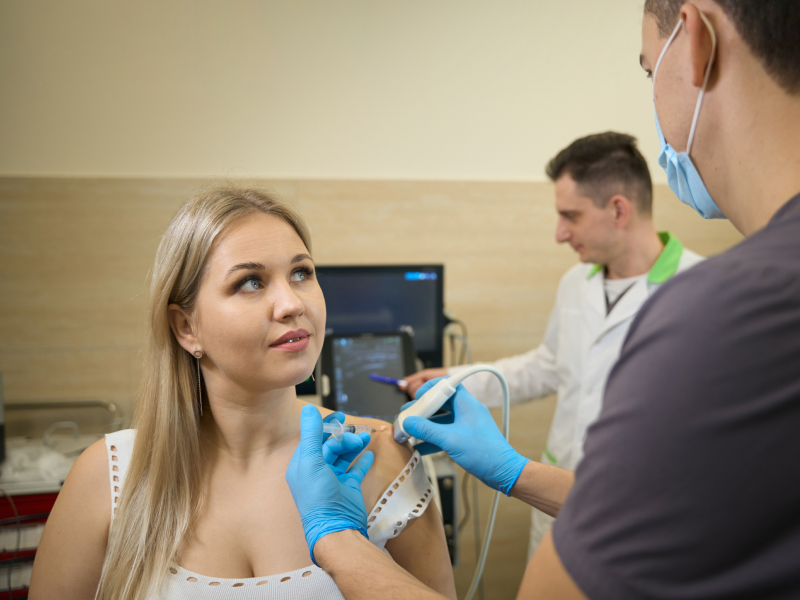This post aims to empower both patients and physicians with a better understanding of POTS and the transformative potential of regenerative medicine for people with postural orthostatic tachycardia syndrome (POTS).
Have you ever stood up quickly and felt light-headed? When we stand, gravity pulls blood into our legs, away from the brain. Within a few seconds, blood vessels in the legs usually tighten, and hearts pump blood up to the brain, so everything’s back to normal. But for between 500,000 and 3 million Americans who live with POTS – mostly women between 15 and 50 years of age—that isn’t necessarily true.
With POTS, everyday activities like getting out of bed, or up from a chair or desk or toilet can cause dizziness, rapid heart rate, fatigue, and other debilitating symptoms.

Even though millions experience it, POTS remains widely misunderstood and often underdiagnosed.
This article aims to shed some light on POTS’ symptoms, and explain how regenerative medicine therapies like PRP (platelet-rich plasma), prolotherapy, stem cell injections, and SGBs (stellate ganglion blocks) offer hope for improved management and healing.
What is POTS?
POTS is a form of dysautonomia, a condition characterized by dysfunction of the autonomic nervous system (ANS), which controls involuntary bodily functions like breathing, heart rate, and blood pressure.
As a blood circulation disorder that affects the ANS, postural orthostatic tachycardia syndrome (POTS) is a chronic condition that causes an abnormally rapid heart rate when a person stands. There’s no cure for it, but various treatments are available.

POTS occurs when the body’s nervous system struggles to regulate blood flow and blood pressure when transitioning from sitting or lying down to standing. This leads to a rapid increase in heart rate (tachycardia) and other symptoms.
While anyone can develop POTS, it is more commonly seen in women of childbearing age and is often triggered by events like infections, surgeries, or significant physical or emotional stress. POTS affects individuals differently, and its symptoms can range from mild to severely disabling.
What’s in a name? Postural – Orthostatic – Tachycardia – Syndrome
Let’s break-down the word to understand this condition further:
Postural – Orthostatic – Tachycardia – Syndrome
- Postural means it relates to your position.
- Orthostatic comes from the Greek for “upright” and “to stand.”
- Tachy- means fast, and -cardia refers to the heart;
together, tachycardia means the heart is beating excessively fast. - Syndrome is a group of symptoms happening together, an important part of POTS.
Together, Postural Orthostatic Tachycardia Syndrome (POTS) is an abnormal increase in high heart rate when standing up from a lying position and can wreak havoc on a person’s day-to-day activities as well as their sense of self and safety.
Symptoms of POTS include:
- Dizziness or lightheadedness
- Fainting
- Heart palpitations
- Blurry vision
- Brain fog & difficulty concentrating
- Shakiness
- Fatigue
- Exercise intolerance
- Nausea and vomiting
- Chest pain
- Headaches
- Cold or discolored extremities
Causes of POTS include:
- Viral illnesses
- Injury, such as a concussion
- Surgery
- Infections
- Puberty or growth spurts
- Pregnancy
- Ehler-Danlos syndrome type III
- Significant stress
Treatment for POTS
There’s no cure for POTS, but lifestyle changes and sometimes medication can help manage symptoms. Staying hydrated, exercising regularly, getting enough sleep, eating a healthy diet, and Increasing salt intake can help.
If you experience symptoms of POTS and are also experiencing dizziness and lightheadedness, it is important to seek medical advice.

For patients, understanding that their symptoms are valid and treatable can be a critical first step toward reclaiming their quality of life.
How Common is POTS?
“POTS is not as rare as it was once believed,” explains NW Regen’s Dr. Ryan Wood who treats patients with POTS in the Portland, Oregon area. “Up to 3 million people in the United States may be living with this condition. Despite its prevalence, awareness among patients and healthcare providers remains limited, which can delay diagnosis and treatment.”
For physicians, recognizing the hallmark symptoms of POTS and employing simple diagnostic tools such as a tilt table test or active stand test can lead to earlier and more accurate diagnoses. Both tools are available and used at NW Regen by Dr. Wood.
Conventional Treatment Approaches
“Traditional approaches to managing POTS often focus on symptom relief rather than addressing underlying causes,” explains Dr. Wood.
“Lifestyle modifications like increasing salt and fluid intake, wearing compression garments, and engaging in structured exercise programs help. And medications to manage blood pressure, heart rate, or neurological symptoms may also be prescribed.”
While these strategies may help, many patients continue to struggle with symptoms and search for additional treatment options. This is where regenerative medicine comes in.

Regenerative medicine focuses on repairing and restoring damaged tissues and systems within the body.
The Role of Regenerative Medicine in POTS Management
For people with POTS, regenerative therapies that focus on repair and restoration of damaged tissues may offer solutions to underlying issues contributing to symptoms.
At NW Regen, Dr. Ryan Wood is an expert in the is a rapidly evolving field of regenerative medicine, and he specializes in personalized regenerative treatments designed to address the unique needs of each patient.
Promising regenerative therapies for POTS include:
1. Platelet-Rich Plasma (PRP):
PRP therapy involves extracting a small amount of the patient’s blood, processing it to concentrate platelets, and injecting it into areas requiring healing. Platelets contain growth factors that promote tissue repair and reduce inflammation. For POTS patients, PRP injections may help address vascular or connective tissue issues that exacerbate symptoms.
2. Stem Cell Therapy:
Adipose-derived stem cells (from your own body) have the unique ability to differentiate into various types of cells and promote regeneration in damaged tissues. Stem cell injections may help modulate the immune response, improve nervous system function, and repair damage to blood vessels, all of which can play a role in POTS.
3. Prolotherapy:
Prolotherapy is a treatment designed to stimulate the body’s natural healing processes by injecting a solution (often dextrose-based) into affected ligaments or tendons. This therapy can help strengthen connective tissue, reduce pain, and improve joint stability—issues that may contribute to POTS symptoms in some patients.
4. Stellate Ganglion Block (SGB):
Stellate Ganglion Blocks or SGBs a type of sympathetic block that involves injecting a local anesthetic into the stellate ganglion—a collection of nerves located in the neck. This procedure temporarily disrupts the sympathetic nervous system, which can help alleviate various conditions, including chronic pain and certain autonomic dysfunctions like PoTS.
Why Choose NW Regen and Dr. Ryan Wood?
Dr. Ryan Wood is a leading expert in regenerative medicine with extensive experience in treating complex conditions like POTS.
At NW Regen, the focus is on delivering personalized care tailored to each patient’s unique health profile and goals. Dr. Wood takes the time to understand your symptoms, lifestyle, and medical history to design a treatment plan that offers the best possible outcomes.
With a commitment to cutting-edge therapies and compassionate care, NW Regen has become a trusted partner for patients seeking to improve their quality of life and regain control over their health. We’re here in Portland, to help you explore your options and create an individualized plan that works for you.
Taking the Next Step
If you or someone you love is living with POTS, there is hope. Advances in regenerative medicine offer new avenues for treatment that go beyond symptom management to address the root causes of this complex condition. Don’t let POTS control your life. Contact NW Regen today to schedule a consultation and take the first step toward healing and renewal. Together, we can move toward a future where POTS is not just managed but truly treated.
NW Regen
We offer regenerative and interventional medicine – tailored to empower you with a more vibrant, active lifestyle.


